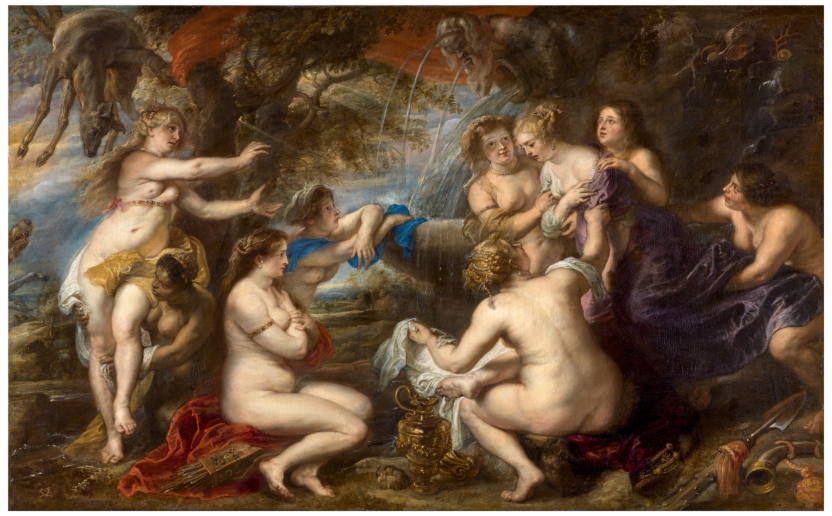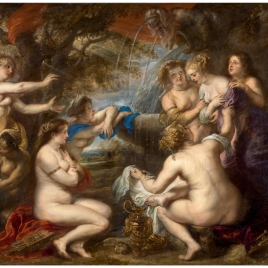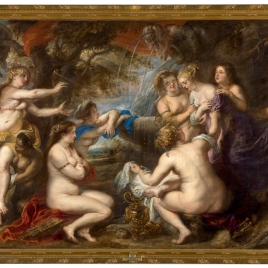Diana and Callisto
Ca. 1635.Room 029
When Rubens visited the Spanish court in Madrid from late August 1628 until April 1629, he copied many of the numerous paintings by Titian in the royal collection. He was seduced by the radical technique of broken brushstrokes characteristic of the late works of the Venetian, which inspired his own way of painting from this time until his death in 1640. He must also have been drawn by the emotional intensity of Titian’s art, one of its most salient qualities. But Rubens was a very different individual than Titian, with a different outlook on life, perhaps shaped by a warmer heart. This shows through in this painting of Diana and Callisto which he produced after his return to Antwerp. In it he offers a reinterpretation of Titian’s version of the myth, one of the compositions that he copied in Madrid.
In Titian’s Diana and Callisto, the lack of empathy and mercy that Diana shows towards the nymph Callisto is shocking. Jupiter was seduced by the beauty of the nymph and reacted to his desire with violence, by raping her. A few months later her pregnancy was uncovered by her companions. To Rubens she inspires pity. The nymphs that disrobe Callisto go about their work casually, as they do in Titian’s painting. But the attitude of Diana is drastically transformed: The goddess reaches out to the nymph with an expression of disbelief and pain. It is hard to believe that she will subsequently punish her - Rubens’s staging of the story makes me feel that when she does, it is against her heart.
Rubens’s transformation of the myth can be linked to his personal life. Since his marriage to his second wife Helena Fourment in December 1630, he painted numerous idyllic scenes complete with personal allusions that are expressions of love at full bloom. Among them are many portraits of Helena, but also the Three Graces and The Garden of Love (they both belong to the Prado), two of his most beautiful and personal paintings; the features of Rubens’s young wife inspired some of the women in these two images. In the context of his own marital bliss (which produced five children), sympathy for Callisto seems natural. In the painting Diana and Callisto she too looks like Helena. And the hairstyle of the nymph next to her is the same as Rubens’s wife wears in several portraits of her. Rubens’s use of a female type inspired by his wife is sometimes explained because she was a convenient model. It is also a reflection of his love.
There are some beautiful passages in this painting. Diana’s long blonde hair moves as she turns - in ancient sources such as Ovid’s Metamorphoses and the Eikones by Philostratus the Elder, moving clothing and hair are a frequent way of expressing dynamism. The belly and breasts of the goddess are also shaped by her movement. The strained pose of the woman who turns her back to us is a pictorial challenge. When describing a painting of Atlas in his book, Philostratus wrote that it showed "a high degree of skill; for the shadows on a crouching figure [...] run into each other [...]". The shadows in Rubens’s figure are also complicated by her pose. In a context of admiration for most things ancient, texts such as this conveyed critical insights from Antiquity. This same figure in Rubens’s painting is based on the very famous bronze from the first century BCE known as the Spinario (or Thorn-Puller) (Rome, Capitoline Museums). The large purple garment worn by Callisto is also inspired by ancient ideas. Purple was more prestigious than any other color in Ancient Greece and Rome. In the Odyssey, Odysseus, still unrecognised by Penelope upon his return to Ithaca, tells her that he once saw the king wearing "a heavy woolen cape, sea purple in double folds". And Eros, in Lucian’s Dialogues of the Gods, tells Zeus to "wear a purple robe" to look more attractive.
Another beautiful and characteristic effect of Rubens’s technique at this point in his career is visible in this painting. Some of the most brightly lit areas - under both arms of the nymph who turns her back, or where the sun rays shine through some of the branches - seem to be at a distance when one backs away from the painting, but become bright passages of dense paint laid on the surface of the canvas when seen up close. The allure of the painting’s illusionism is palpable in these passages. The rays of sun are particularly beautiful. As they find their way through the foliage, they evoke the idea of an animated natural world. Few if any landscape paintings by other artists conjure this idea with the plenitude that Rubens manages; here we get a taste of it (Vergara, Alejandro, in Mythological Passions, Museo Nacional del Prado, 2021, pp. 138-142).








































